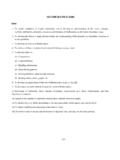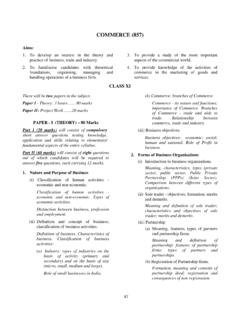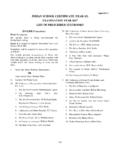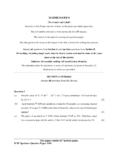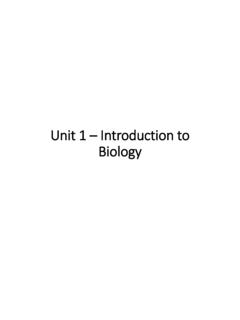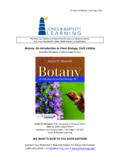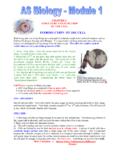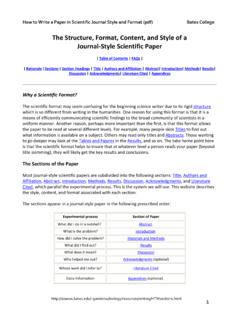Transcription of SCIENCE (52) BIOLOGY SCIENCE Paper -3 - CISCE
1 101 SCIENCE (52)BIOLOGYSCIENCEP aper-3 acquire the knowledge of the economicimportance of plants and develop anunderstanding of the inter-relationship between sustainability andenvironmental develop an understanding of theinterdependence of plants and animals so as toenable pupils to acquire a clearer comprehension ofthe significance of life and its importance in understand the capacities and limitations of allthe biological and economic activities so as to beable to use them for a better quality of acquire the ability to observe, experiment,hypothesis, infer, handle equipment accurately andmake correct IXThere will be one paperoftwohoursduration of 80 Marks and Internal Assessment of Practical WorkCarrying 20 Paper will be divided intotwosections, Section I(40 marks) and Section II (40 marks).Section I (compulsory)will contain short answerquestions on the entire IIwill containsixquestions.
2 Candidates willbe required to answer anyfourof Basic BIOLOGY (i)The cell, a unit of life, protoplasm, basicdifferencebetween prokaryotic and eukaryoticcell; differences between an animal and a basic understanding of the cell theory,structure of plant and animal cell withfunctions of various cell organelles.(Protoplam, Cytoplasm, Cell Wall, CellMembrane, Nucleus, Nucleolous,Mitochondria, Endoplasmic Reticulum,Ribosome, Golgibodies, Plastids, Lysosomes,Centrosome and Vacuole). Difference betweena plant cell and an animal cell should bemainly discussed with respect to cell wall,centrosomeand vacuoles and plastids.(ii)Tissues: Types of plant and animal be taught in brief with respect to location,basic structure and function, giving typicalexamples of their location so as to enablepupils to understand their role in differentphysiological processes in plants and Flowering Plants(i)Vegetative Propagation:Artificial methods,advantages and disadvantages.
3 Economicimportance ofartificialpropagation, MicroPropagation. Briefidea of Biotechnology and its applications rolein medicine and concept in brief with suitable methods: cutting, grafting andlayering withexamples. Advantages anddisadvantages of vegetative reproduction to importance : Meaning and :meaning, uses idea of biotechnology(example-humaninsulin from : in medicine penicillin,tetracycline;in industry(example cheese,vinegar, yogurt, alcoholic beverages;synthesisof vitaminsnamelyvitamin C;andenzymes-namelylipase).(ii)Flower: Structure of a bisexual flower,functionsof brief introduction to complete andincomplete flowers. Essential and non-essentialwhorlsof a bisexual flower;theirvarious partsand functions. Use of charts oractual specimens help enhance clarity placentation (types arenotrequiredin both cases).(iii) Pollination: self and , advantages anddisadvantages ofself and cross-pollination, agents ofpollination and the characteristic features offlowers pollinated by various agents to bediscussed.)
4 (iv) taking place between pollination andfertilisationshould be discussed up to fusion ofmale gamete with egg cell in the embryo should be familiar with the termsdouble fertilization and triple fusion. Fruit andSeed (definition)and significance of Fruit Plant Physiology(i)Structure of dicot and monocot seeds,Germination of seeds, types, and conditions germinationof Bean seed andMaize between hypogealand epigeal for seedgermination should be dealt with byexperiments.(ii)Respiration in plants: outline of the process,gaseous brief outline of the process mentioning theterm Glycolysis,Krebs cycleand to be made toaerobicand anaerobic respiration with chemicalequations in each ongaseous exchange and on heat in living organisms / Eco systems(i)Understanding ecosystems between biotic and abiotic component consisting of producers,consumers, decomposers.
5 Terms of food chain,food web, account ofAbiotic or nonlivingcomponents such as air, soil, water andclimatic factors like sunlight,temperature,humidityand Ecosystemwith its flora and faunato be taught.(ii)A brief outline of five Kingdom classification:Main characteristicsof eachkingdomwithsuitable examplesMonera, Protista, Fungi,Plantae(Thallophyta, Bryophyta,Pteridophyta and Spermatophyta)andAnimalia(Non-chordates from Porifera toEchinodermataandChordates-all fiveClasses)(iii)Economic importance ofBacteria:Economic importance of bacteria:Useful roleof bacteria-medicine (antibiotics,serums and vaccines);agriculture; (nitrogenfixing, nitrifying and denitrifying bacteria)andindustry (curing of tea, tanning of leather)Harmful roleofbacteria inspoilage of food,disease in plants and animals, bio-weapons,denitrification.(iv)Economic importance ofFungi:Economic importance of Fungi:Useful roleof Fungiinbreweries, bakeries,cheeseprocessing, mushroom cultivation(Processesof manufacturearenot requiredineach case).
6 Anatomy andPhysiology(a)Nutrition:(i)Classes of food:balanced and deficiency of carbohydrates, fats, proteins,mineral salts (calcium, iodine, iron andsodium), vitamins and water in properfunctioning of the body to be of vitaminstheir functions anddeficiency diseases to be should be familiar with the term Balanced Diet . Importance of cellulosein our diet should be discussed. Studentsshould be taught about Kwashiorkor (ii)Thestructure of a tooth, different types of a tooth to be discussed withthe help of a diagram. Functions ofdifferent types of teeth must also be taught.(iii) Digestive System: Organs and digestiveglands and their functions (includingenzymesand their functionsin digestion;absorption, utilisation of digested food);tests for reducing sugar, starch, protein and their functions; functions ofsaliva; brief ideaofperistalsis; digestionin various parts of alimentary canal.
7 Testsfor sugar, starch, protein and fats.(b)Movement and Locomotion:(i)Functions of human skeleton(ii)Axial and Appendicular Skeleton(iii)Types of joints immovable, slightlymovable and freely movable(hinge joint,ball and socket joint, gliding joint, pivotjoint.)(c) Structure and functions of parts of the skin and their functions tobe taught with the help of diagrams; heatregulation, vasodilation, vasoconstriction tobe explained.(d)RespiratorySystem: Organs; mechanism ofbreathing; tissue respiration, heat between anaerobic respiration inplants and in man. Brief idea of respiratoryvolumes, effect of altitude on breathing andasphyxiation should be taught. Role ofdiaphragm and intercostals muscles inbreathing must be explained to provide a clearidea of breathing process. Brief idea ofgaseous transport and tissue respiration to and HygieneCause of diseases:(i)Bacteria-types of bacteria,bacterial control,three examples of diseases caused by Tuberculosis, Tetanus, Syphilis (Veneraldisease).
8 (ii)Virus-nature of viruses, three examples ofviral diseases Poliomyelitis, Mumps,Rabies, etc. Introduction to HIV, its outlinestructure and spread.(iii)Parasites-two examples, roundworm,tapeworm and their control.(iv)Brief idea of endemic, epidemic, pandemic,and sporadic.(v)Hygiene: simple personal hygiene and socialconditions affecting this. Diseasecarriers(vectors) flies, rats and cockroaches,contamination of water,waterborne idea of personal hygiene, publichygiene and sanitation, control of housefly,mosquitoes, cockroaches and rats(life historynot required). Water borne diseases likecholera, dysenteryand generation and management(a)Sources of waste-domestic, industrial,agricultural, waste: Paper , glass, plastic, rags,kitchen waste, :mining operations, cementfactories, oil refineries, construction :plant remains, animal waste,processing :Sewage, degradable andnon-degradablewaste from offices, : brief idea about e-waste.
9 (b)Methods of safe disposal of waste: segregation,dumping, composting, drainage, treatment ofeffluents before discharge, incineration, use ofscrubbers and electro static of domestic waste intobiodegradable and non-biodegradable byhouseholds:sweeping from gardens to beconverted to compost; ASSESSMENT OFPRACTICAL WORKThe practical work will be designed to test the abilityof the candidates to make accurate observations fromspecimens of plants and animals. For this, candidatesshould be familiar with the use of a hand lens of notless thanx6 magnification. They should be trained tomake both simple and accurate drawings and briefnotes as a means of recording their practical examiners will assume that candidateswould have carried out the practical work : Candidates are expected to have a basic ideaof plant LIFE(i)The examination of an onion peel under themicroscope to study various parts of the should be given an idea of removal ofonion peel, staining, mounting the specimen andhandling the microscope.
10 They should observe thestructures and drawlabelleddiagrams.(ii)A cross-pollinated flower to be examined andidentified and the parts to be studied and should be provided to the students fromwhich theyshould be asked to draw diagramsshowing the various flower to be discussed in order of the fourwhorls with diagrams of the complete flower,reproductive parts and of ovary to show thearrangement of ovules. Students should drawdirectly from the specimen provided so that theyhave a clear idea of the whorls and their location.(iii)Specimens of germinating seedswith plumule andradicle(the bean seed andmaizegrain) forexamination, identification, drawing and labellingthe in water should be provided. Thestudents themselves should see the external andinternal structure so that they can identify thevarious parts and draw and label LIFE(i)The examination of a human cheek cell under themicroscope to studyvarious parts of the should be given an idea of staining,mounting the specimen and handling themicroscope.



